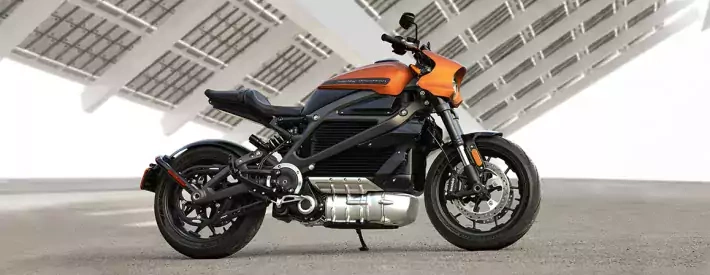(E)asy-rider

In this article: Motorcycles could be the answer to our changing mobility needs, but where are the clean and efficient electric bikes that can whizz us through town?
When you think of a motorcycle, what springs to mind may well be a Harley- Davidson – a big, V-twin-engined beast made for tearing through vast expanses of American wasteland. Or maybe you picture a Vespa zipping through the streets of a European city, its horn blaring and two-stroke engine chugging away as it weaves in and out of traffic.
These are the classic images of motorcycling, but things are definitely changing. A statement at last year’s ACEM conference on the European motorcycle industry declared: “Technology is changing faster than policy. If the motorcycle industry is to become an urban solution, future vehicles must not just be low-emissions, but zero-emissions.”
So the motorcycle industry recognises the challenges ahead. Manufacturers see that they need to move away from the leisure industry and focus instead on basic transport needs if they hope to win greater acceptance as part of governments’ transport strategies.
However, the industry seems to be off the pace. Passenger vehicles are already firmly on the road to alternative fuels, but where are the motorcycle equivalents? Strangely, the push is coming from the last place you’d expect.
Born to be wired
Back in 1903, when a small wooden shed in Milwaukee, Wisconsin became the birthplace of iconic motorcycle brand Harley-Davidson, a bike for basic transport needs seemed an impossible dream. But for William Harley and brothers Arthur and Walter Davidson, it was a dream worth pursuing.
More than 100 years on, Harley-Davidson is famous for its large-capacity, air-cooled V-twin internal combustion engines. However, these engines power machines that are primarily used for leisure rather than for getting the masses from A to B.
In an effort to turn that around, and with sales of the premium product floundering in the US and worldwide, Harley-Davidson has hit the headlines recently by launching an electric motorcycle called the LiveWire. It may bear that all-important family name, but it has next to nothing in common with the historic line of which it is the latest progeny.
Of course, other electric bikes are already on the market – mainly small scooter-type machines and larger bikes from new manufacturers such as American brand Zero. The LiveWire, by contrast, is the first proper electric motorcycle to be produced by an established manufacturer. It’s a return to those early pioneering ways for Harley-Davidson.
The specifications read like something you’d expect to find in an electronics store. This bike is clearly aimed at a younger, more tech-savvy audience than Harley- Davidson’s traditional buyer. A full charge takes an hour, and 40 minutes plugged in to a fast charger will get you to 80% capacity. The range is listed as 146 miles in town and 70 miles on the open road.
Harley-Davidson has gone the whole hog too, with plans to set up 250 dealers worldwide with specialist technicians and 24kW charging stations. Twelve of these dealers will be in the UK.
The newly released LiveWire will set you back £28,995 in the UK, making it more expensive than many of the traditional air-cooled V-twin models. That’s a big price tag, but Harley-Davidson has always been a premium product. The question is this: where are the other major manufacturers with more realistically priced electric motorbikes that can be used as basic transport?
Coming to a dealer near you?
Major manufacturers such as BMW have exhibited concept bikes such as the Vision DC Roadster, but the German giant has only produced electric scooters to date. Yamaha has produced plenty of small electric two-wheelers, and other firms have released prototypes or registered patents for electric bikes, including Kawasaki.
However, The Japan News recently reported that the Big Four – Honda, Suzuki, Kawasaki and Yamaha – are now in talks to agree a common unified standard for charging stations and batteries, enabling them to be shared between brands. If successful, that would eliminate a significant barrier to the take-up of electric bikes.
Taiwanese manufacturer Kymco has been promoting removable and replaceable batteries for some time and is now championing its Noodoe
system in its home market. Basically, Noodoe is a cloud-based electric vehicle charging point. Just like a conventional petrol pump, you plug in, charge your battery and then pay by card.
So it seems that the manufacturers are looking to the future and considering ways to make electric bikes more appealing to accelerate the very slow take-up.
On the limit
The Isle of Man Zero TT event has already demonstrated that electric motors are capable of propelling bikes to more than 150mph and can look quite conventional. However, range is still a big issue outside towns and cities – as is the cost of the battery packs.
The infrastructure is going to be the major stumbling block in the promotion of electric vehicles, no matter how many wheels they have. What’s more, that infrastructure is currently beyond the industry’s control.
Convincing existing riders to abandon the familiar noise and feel of petrol engines is going to be even harder, particularly bearing in mind that diesel bikes failed to inspire much interest. The age demographic for motorcycling in general is a worrying factor too. It is the older generation that can afford the current high prices, but these silver riders will be more entrenched in their preferences.
That said, Harley-Davidson has demonstrated that electric bikes are now here – in all sizes. It’s now just a question of making them cheaper, increasing their range and expanding the infrastructure to make them attractive to new riders. It may be the only way that motorcycling can survive as a mass transport solution – which, after all, is how it started.




